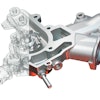In the age of Amazon, there has been a surge in expanding the direct-to-consumer shipping model among retail distributors. Ecommerce is becoming the preferred method of shopping, growing 23 percent year-over-year. More than 50 percent of Gen Xers and almost 70 percent of Millennials prefer online shopping. As the shift toward direct-to-consumer occurs, distributors will need to overcome some of the more prevalent challenges posed by the model.
Managing thousands of small parcel shipments a day requires maximum efficiency, accuracy and speed — of both data and product — throughout the entire supply chain. ERP software continues to play a pivotal role in how effective a drop shipping program can be.
The following are some of the top challenges facing retail distributors embarking on the direct-to-consumer model and how the right ERP technology can help.
High Speed Fulfillment is the New Normal
The days of having a week or more to fill orders is long gone. In just three years, the average time from order placement to delivery has decreased 60 percent. Aside from unprecedented eCommerce volume, more than 60 percent of consumers are willing to pay for the convenience of same day delivery, which has made life interesting for distributors — to say the least.
Today, distributors often have a 24-hour shipping window to meet. Most distributors will receive an order through EDI, identify that it needs to be shipped within 24 hours, retrieve the items from the warehouse and ship them out. Consumer orders require careful attention to ensure the right products are packaged. Because the process is more labor-intensive, the potential for mistakes is higher. Picking the wrong item not only leads to customer dissatisfaction, but also return orders that require further handling. One misstep in the process could impact turnaround time and result in costly retailer chargebacks that erode your margin.
The Cost of Picking Can Climb
While seemingly a smooth process in the eyes of consumers, direct-to-consumer shipping is proving to be a warehouse logistics headache for many retail distributors in the age of eCommerce.
For several distributors, order volume has increased from hundreds of bulk orders direct to the retailer’s distribution center, to thousands of small, individual orders direct to the customer. The high order volume and small pick quantity is becoming costly for distributors. Instead of picking 50 identical orders, warehouse workers now must pick 50 unique orders, each with their own quantities and attributes. This change calls for greater efficiency or distributors run the risk of losing money.
It’s also worth noting that employee turnover in the warehouse is at an all-time high, so the onboarding process for new hires must be accelerated. How much time in your onboarding process is concentrated on process and system usage? Too long? Retail distributors need to have employees working efficiently within a couple days, not a couple weeks. Onboarding is especially important during peak seasons. As order volume spikes, distributors often need to hire temporary workers. There is no time to take days to train a part-time worker on a Warehouse Management System (WMS). They need to be efficiently picking and packing right away, with minimal guidance.
Staying Brand Compliant and Avoiding Mishaps with Inefficient Processes
Keeping up with compliance is also a growing concern of retail distributors taking on drop shipping. Vendors like Target and Walmart continue to increase chargeback fines, leaving shippers exposed, and some retailers count these fines as up to 13 percent of their account revenue. One of the more common issues deals with branding. Retail distributors are expected to dynamically customize shipping labels and pack slips for thousands of orders to reflect the retail brand orders they are fulfilling. Failure to meet these requirements can result in being penalized with chargebacks for noncompliance.
Say, for example, you’re fulfilling orders for Walmart.com. What you’re shipping to the consumer has to appear as if it is coming from a Walmart store, which means the branding has to reflect Walmart, and the shipping labels and pack slips have to include Walmart information. Additionally, you need to ensure you are following the retailer’s shipping rules. Each retailer has their own requirements that must be followed, and they can even vary based on the package weight. You cannot stop during the picking process to look up this information and manually handle each shipment. For maximum efficiency, the business rules need to be predefined in your ERP, which should automatically make the right selections as the order is being picked and packed.
Often, retailers with legacy ERP systems must print labels and pack slips from a retailer-provided portal and then marry that information with the items they are shipping out. As with most manual processes, it is extremely error-prone, as distributors have to navigate outside their systems and manually match up the information with the right packages.
Comprehensive ERP Solutions to the Rescue
Are you grappling with these challenges? It’s probably time to take a closer look at your ERP system and decide if you need to invest in new technology that can keep up with the rigors of an eCommerce direct-to-consumer distribution model.
Take the labelling process, for example. An advanced ERP can brand and print shipping labels and pack slips within the solution with tracking numbers. No more portal hopping, printing and manually matching the labels and pack slips with their respective orders — it’s all streamlined within the picking process.
It’s critical to select an ERP solution that’s intuitive and truly comprehensive. You want to implement ERP technology that can integrate with EDI and your WMS, or offer those solutions under one umbrella. When you have a 24-hour turnaround time to get an order out, you cannot afford to waste time getting orders from some other EDI systems, inputting that information into your ERP, then transferring it to the WMS. Comprehensive and quality integrations are the key to getting orders fulfilled on time, keeping warehouse costs low and preventing retailer chargebacks.
Ultimately, the drop ship model is only going to continue to grow. Now is the time to ensure that you have the tools in place to meet the demand.
John Weber is Director of Business Development and Product Management at Aptean.






















